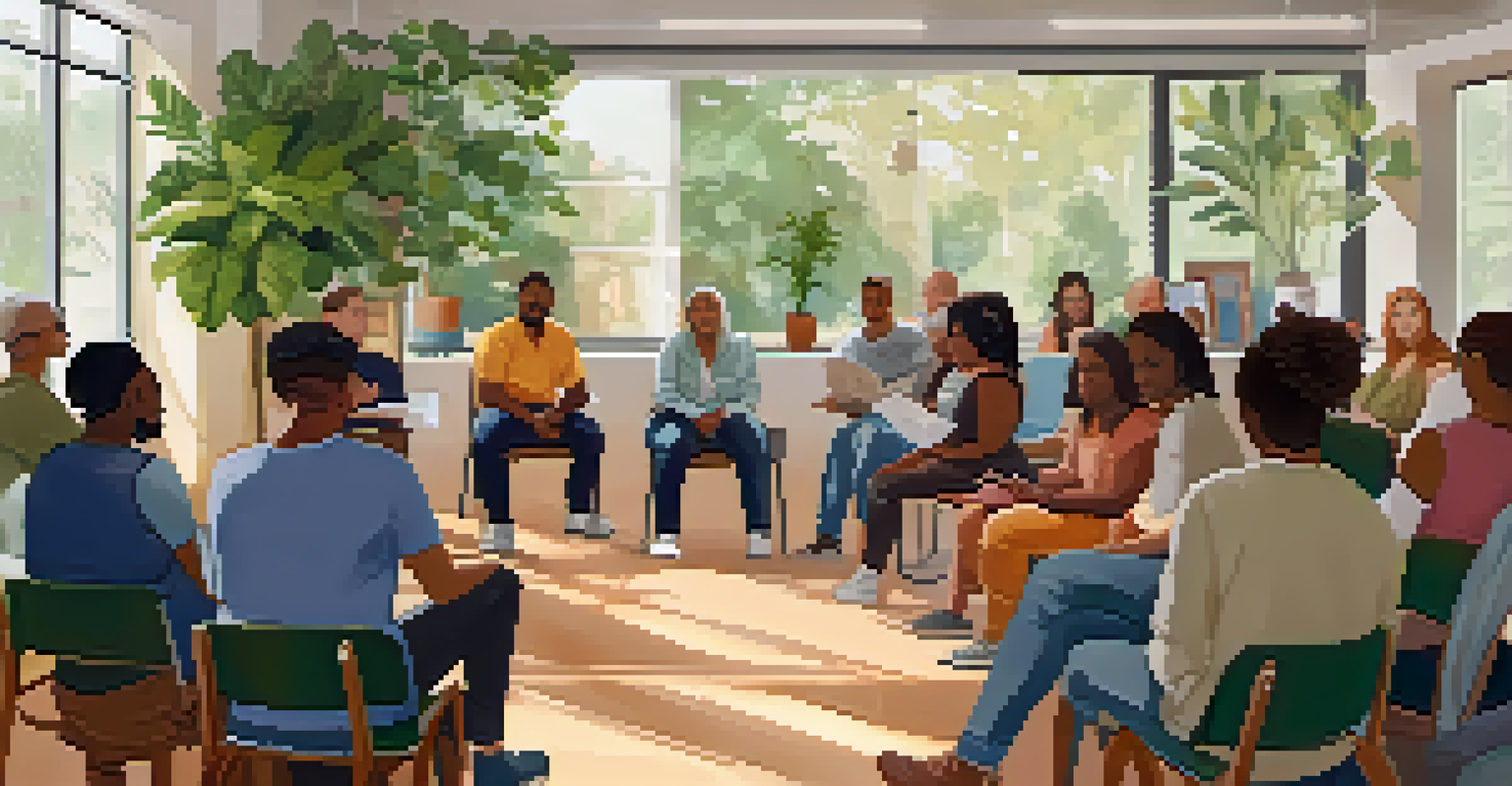Community Resilience: Strengthening NYC in Crisis Situations

Understanding Community Resilience in NYC
Community resilience refers to the ability of a community to withstand and recover from adverse situations, such as natural disasters or public health crises. In New York City, where diverse populations and varying resources exist, building this resilience is crucial. It’s not just about bouncing back; it’s about bouncing forward, evolving stronger than before.
Resilience is not a destination, but a process of becoming stronger after adversity.
The fabric of NYC is woven from stories of neighborhoods coming together during emergencies, showcasing a spirit of solidarity. For instance, during Hurricane Sandy, local organizations mobilized quickly to assist those affected, highlighting how interconnectedness fosters resilience. This collective response not only helps in immediate recovery but also sets the stage for long-term community growth.
Investing in community resilience means investing in the people and systems that support them. By focusing on education, resources, and communication, NYC can prepare for future crises more effectively. Ultimately, it’s about creating a culture where every resident feels empowered to contribute to their community’s safety and well-being.
Building Stronger Neighborhood Networks
One of the key components of community resilience is strong neighborhood networks. When residents know each other and collaborate, they can respond more effectively in times of crisis. For example, block parties or community gardens are not just fun gatherings; they foster relationships that can be crucial during emergencies.

These networks provide a support system where neighbors can share resources, information, and skills. In a city like NYC, where the pace of life can be overwhelming, these connections often serve as a lifeline. Whether it’s sharing food during a power outage or organizing a community cleanup after a storm, the impact of these networks is profound.
Community Resilience is Essential
Building community resilience in NYC involves empowering residents to withstand and recover from crises through interconnectedness and collective action.
Moreover, strengthening these connections doesn’t require grand plans or significant funding; it can start with simple conversations. Initiatives like neighborhood watch programs or local meetups can pave the way for lasting ties. In essence, the more connected a community is, the more resilient it becomes when faced with adversity.
The Role of Local Organizations in Resilience
Local organizations play a pivotal role in enhancing community resilience, acting as both first responders and long-term support systems. They often have the local knowledge and networks necessary to mobilize resources quickly. For instance, food banks and shelters were essential during the COVID-19 pandemic, providing immediate relief to those in need.
The greatest weapon against stress is our ability to choose one thought over another.
These organizations also offer training and resources to empower residents, teaching skills that can be invaluable during crises. Workshops on emergency preparedness, mental health support, and basic first aid can equip individuals with the tools they need to respond effectively. As a result, communities become more self-sufficient and less reliant on outside assistance.
Additionally, local organizations often serve as a bridge between residents and government resources. They help residents navigate systems for aid and recovery, ensuring that everyone has access to the support they need. This connection fosters trust and reinforces the idea that resilience is a shared responsibility.
Education as a Cornerstone of Resilience
Education is a vital factor in building community resilience, equipping individuals with knowledge that can save lives. Schools in NYC are increasingly incorporating emergency preparedness into their curricula, teaching students about disaster response. This early education helps create a culture of awareness and readiness that extends beyond the classroom.
Moreover, community workshops can help adults learn about crisis management, financial planning, and mental health resources. By providing access to this information, communities empower residents to take proactive steps in their own lives and neighborhoods. The more informed residents are, the more capable they are of handling emergencies.
Local Organizations Drive Support
Local organizations are crucial for community resilience, providing immediate relief, resources, and training that empower residents to respond effectively during emergencies.
Ultimately, education fosters a sense of agency among community members. When individuals understand the risks they face and know how to respond, they contribute to a collective resilience. This empowerment transforms the way communities navigate crises, shifting the focus from reaction to preparedness.
The Importance of Communication in Crises
Effective communication is essential in times of crisis, serving as the backbone of community resilience. During emergencies, clear and timely information can help residents make informed decisions and stay safe. NYC has made strides in improving communication strategies, utilizing social media, text alerts, and community meetings to disseminate information.
However, it’s not just about broadcasting information; it’s about ensuring that it reaches everyone. Language barriers, technological gaps, and varying levels of access can hinder effective communication. Therefore, it’s crucial for community leaders to adopt inclusive strategies that engage all residents, ensuring no one is left in the dark during a crisis.
Moreover, encouraging open dialogue within communities fosters trust and collaboration. When residents feel heard and valued, they are more likely to participate in resilience-building efforts. In this way, communication becomes a two-way street, where sharing information leads to stronger, more cohesive communities.
Leveraging Technology for Community Resilience
In our increasingly digital world, technology plays a significant role in enhancing community resilience. From social media platforms that facilitate real-time updates to apps that connect neighbors, technology can bridge gaps during emergencies. For instance, community alert systems can quickly inform residents about impending threats, giving them time to prepare or evacuate.
Additionally, technology can support resource-sharing among community members. Platforms that allow residents to offer or request help can strengthen local networks. During the pandemic, many neighborhoods utilized apps to coordinate food deliveries and share supplies, highlighting how technology can foster collaboration and support.
Mental Health Matters in Recovery
Prioritizing mental health resources enhances community resilience by helping residents cope with stress and fostering stronger community bonds during crises.
However, while technology can enhance resilience, it’s important to ensure that all community members have access to it. Digital literacy programs can help bridge this gap, ensuring that everyone can benefit from these tools. By leveraging technology wisely, communities can create a more connected and resilient environment.
Emphasizing Mental Health in Resilience Planning
Mental health is a critical aspect of community resilience that often goes overlooked. During crises, the emotional toll can be just as devastating as physical damage. Recognizing this, NYC has been increasingly focusing on mental health resources as part of its resilience strategy, ensuring that residents have access to support during tough times.
Community programs that promote mental wellness can help individuals process their experiences and cope with stress. Initiatives such as counseling services, support groups, and wellness workshops create safe spaces for residents to share their feelings. Acknowledging mental health as part of resilience not only aids recovery but also fosters a stronger sense of community.

Moreover, encouraging open conversations about mental health reduces stigma and promotes understanding. When residents feel comfortable discussing their struggles, it strengthens community bonds and enhances overall resilience. In this way, mental health becomes a shared priority, reinforcing the notion that we’re all in this together.